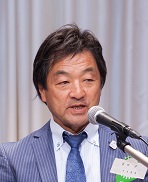How to Prevent Roadway Sinkholes across Japan
May 17, 2017
Mr. Hiroshi Tomita
President, GEO SEARCH CO., LTD.
�� I established Geo Search Co., Ltd. in 1989 at the age of 35 and launched practical applications of the world��s first subterranean cavity probe system in the following year. Upon request of the United Nations Mine Action office, we developed a technology to detect anti-personnel landmines in 1992 and implemented landmine clearance operations over 10 years around the ancient ruins of the Khmer Empire, currently registered as the UNESCO World Heritage Site. In 2008, we succeeded in upgrading the mine detection technology to activate the world��s first SKELE-KA Services. It enables accurate and speedy investigation of subterranean cavities through high-resolution and high-speed visualization of underground skeleton images. When the Great East Japan Earthquake happened in 2011, we conducted an emergency investigation and detected 10 times more cavities than in normal times beneath the main roads and along the subway in Sendai. Frequent aftershocks hampered repair operations and it took more than a year and a half for recovery.
I established Geo Search Co., Ltd. in 1989 at the age of 35 and launched practical applications of the world��s first subterranean cavity probe system in the following year. Upon request of the United Nations Mine Action office, we developed a technology to detect anti-personnel landmines in 1992 and implemented landmine clearance operations over 10 years around the ancient ruins of the Khmer Empire, currently registered as the UNESCO World Heritage Site. In 2008, we succeeded in upgrading the mine detection technology to activate the world��s first SKELE-KA Services. It enables accurate and speedy investigation of subterranean cavities through high-resolution and high-speed visualization of underground skeleton images. When the Great East Japan Earthquake happened in 2011, we conducted an emergency investigation and detected 10 times more cavities than in normal times beneath the main roads and along the subway in Sendai. Frequent aftershocks hampered repair operations and it took more than a year and a half for recovery.
��When the vast sinkhole accident occurred near JR Hakata Station last November, we were requested by the City of Fukuoka to carry out an emergency survey to ensure safety of the area. To everyone��s surprise, the repair work took only one week thanks to the rapid response taken by the City. I had a chance to discuss the importance of preventing sinkholes with the Mayor this January. The City decided to conduct a comprehensive survey on cavities and to initiate a joint research with the University of Tokyo. In April, all local municipalities in Kyushu signed an epoch-making Memorandum to collaborate in the event of large-scale natural disasters and to work towards disaster prevention and risk management.
��The 1995 Great Hanshin-Awaji Earthquake caused extensive damage to the roads, triggered traffic congestion and delayed emergency rescue operations which resulted in the loss of more than 500 precious lives. We also witnessed numerous sinkholes on the roads in the wake of Kumamoto Earthquake last year. By using 5 SKELE-Cars in Kumamoto, we detected and repaired about 700 sinkholes in 2 months.
��Here in Japan, more than 5,000 sinkholes form each year, caused by subterranean cavities. Sinkholes are found all over the world, including Russia, U.S.A., Taiwan, China and South Korea, and most commonly in the metropolitan areas. They can be natural or man-made, caused by erosion, geological conditions and formation, earthquakes, torrential rain, drilling and mining as well as decrepit or damaged infrastructure.
��I must say Tokyo has the largest number of subterranean cavities, due to its intricate underground structure and facilities which accommodate 13 subway lines, water and sewage pipes, electric cables, gas pipes and telephone lines. Our 5-year subterranean survey showed one cavity per 500 meters, making Tokyo��s roadway network full of holes. The Disaster Management Plan stipulated by the Tokyo Metropolitan Government puts emphasis on preventing collapse of buildings and fire-fighting, but research results show that road blocks caused by sinkholes will have a far greater impact in cases of natural disasters. Taking into account the lessons learnt from the Great East Japan Earthquake, our company has formulated a comprehensive SKELE-KA inspection method which allows subterranean cavity survey at half the cost with one-tenth of time required from survey to repair work. I suggest using our SKELE-KA technology to prevent sinkholes estimated to total 10,000 along the national, metropolitan and ward roads extending over 5,000 kilometers. We are capable of making surveys for 2,000 kilometers each year and complete repair works by the time Tokyo will host the Olympic and Paralympic Games in 2020.
��With the ultimate goal to safeguard people��s lives and livelihoods, we aim to prevent sinkholes to prevent accidents in normal times and secure smooth traffic network in emergency situations. SKELE-KA inspection conducted in Ohta Ward detected largest number of cavities in narrow roads where ambulances come and go and we could immediately repair them. We are determined to continue our efforts to minimize damages caused by disasters by building resilience of necessary facilities and surrounding routes.
��We also receive survey requests from overseas and have worked in freezing temperatures in Seoul and extreme heat in Bangkok. To date, we have conducted surveys for a total road length of 171,474 kilometers, worth more than four times around the earth, and have detected over 50,000 cavities. We have 30 SKELE-Cars deployed across Japan, ready to conduct emergency surveys within 12 hours should any natural disaster occur.
��When I turned 60 in 2015, I began a three-year lecture program in the field of ��Contribution Engineering and Disaster Reduction Studies�� at my alma mater Keio University, Faculty of Science and Technology. I believe human resource development is the key to build a disaster resilient society and aim to teach engineering ethics to students who will be ready to work for the safety and welfare of the public.